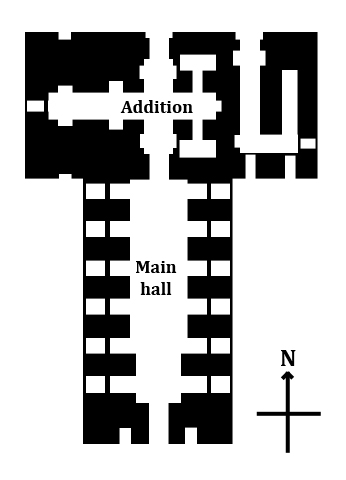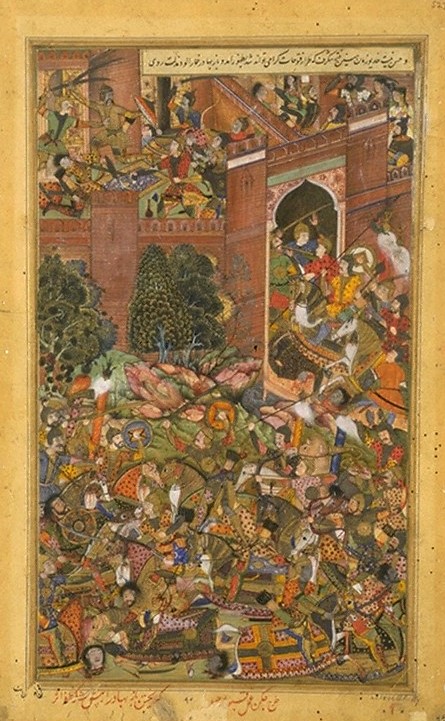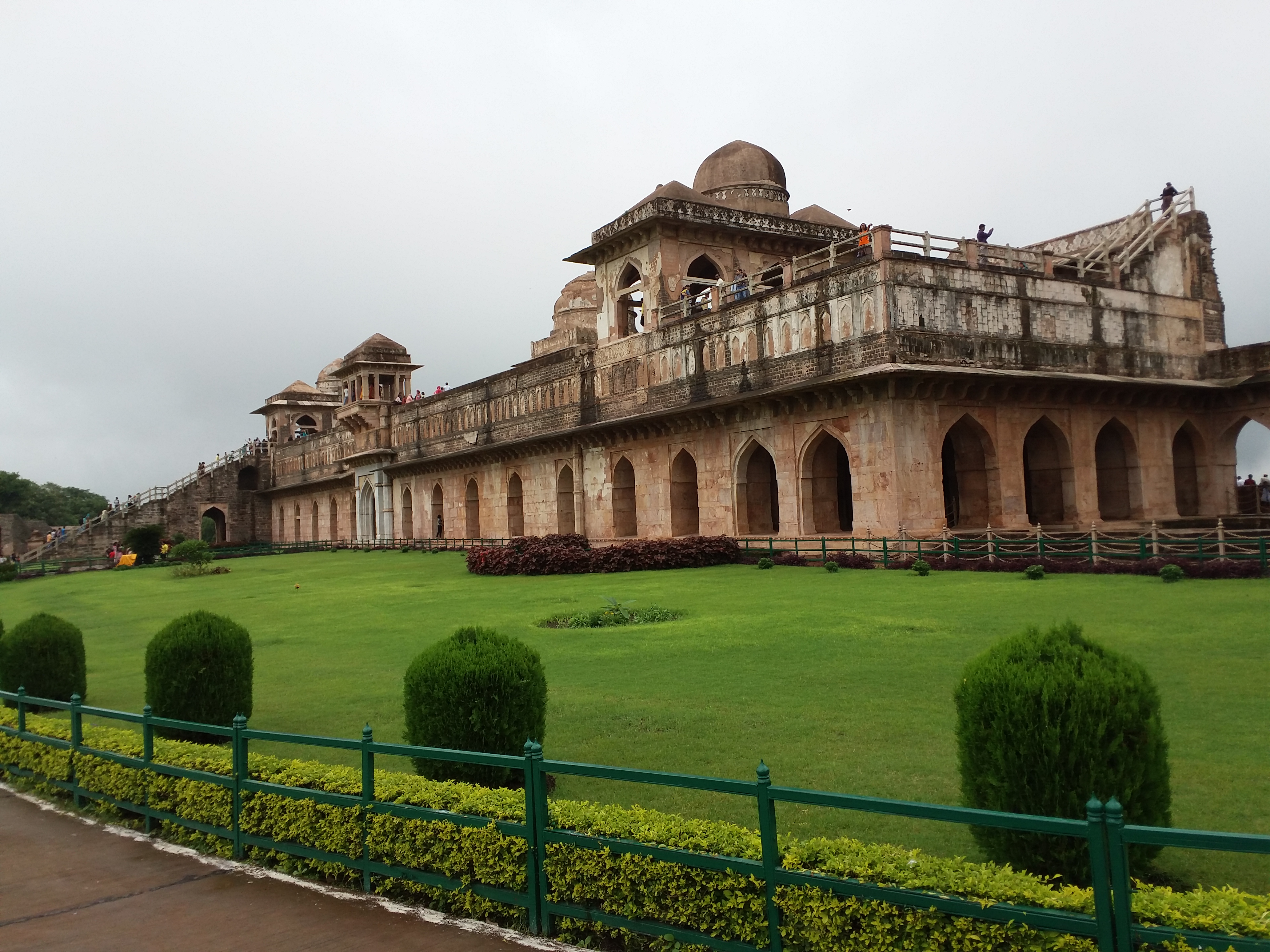|
Hindola Mahal
The Hindola Mahal (English translation: “Swinging Palace”), is a large meeting hall, or Durbar (court), durbar, in the ancient Indian city of Mandu, Madhya Pradesh. Today the Hindola Mahal is a tourist destination in the ruined city. History The Hindola Mahal might have been constructed during the reign of Hoshang Shah about 1425 C.E. but may date to the end of the 15th century during the reign of Ghiyath Shah, Ghiyas-al-Din. It is one of a set buildings making up the royal palace complex at Mandu, which consists of the Jahaz Mahal, the Hindola Mahal, the Tawili Mahal, and the Nahar Jharokha. The Hindola Mahal may have been used as an audience chamber. Architecture The plan of the Hindola Mahal is a T-shape, though examination of the exterior walls leads to the conclusion that the crossbar was added later. The vertical mast of the plan consists of one main hall measuring and high. Its lateral walls are thick and further reinforced by massive inclined buttresses th ... [...More Info...] [...Related Items...] OR: [Wikipedia] [Google] [Baidu] |
Hindola Mahal, Mandu, India
Hindola is popular festival celebrated in Hinduism. In this festival, idol of Krishna, Lord Krishna is placed on the swing and is rocked by his devotees. History The festival finds its origin in the streets of Vrindavan over 5000 years ago where the Gopis rocked Krishna on a decorated swing. Ever since, to experience the divine joy of rocking Krishna in a small swing, the hindola festival became the focus of devotion. Hindola originates from the Pushtimarg sect. In Pushtimarg, Hindola is made of wood, gold, silver. They are decorated with flowers, fruits, dry fruits, vegetables, pavitra garlands, rakhis, glass, jari, pearls etc. Hindola remains one of the most auspicious festivals for Pushtimarg, Pushtimarg Vaishnavs. Every day in the month of Shraavana, the Hindola is decorated with different material (mirrors, flowers, colors etc). Occurrence It occurs in the months of (Ashadh/Shravan) in the Vikram Samvat calendar. Mainly from Ashadh Vad 2nd to Shravan Vad- 2 every year. ... [...More Info...] [...Related Items...] OR: [Wikipedia] [Google] [Baidu] |
Durbar (court)
Durbar is a Persian-derived term (from fa, دربار - ''darbār'') meaning the kings’ or rulers’ noble court or a formal meeting where the king held all discussions regarding the state. It was used in India for a ruler's court or feudal levy as the latter came to be ruled and later administered by foreigners. A durbar may be either a feudal state council for administering the affairs of a princely state, or a purely ceremonial gathering, as in the time of the British Empire in India. The most famous Durbars belonged to great Emperors and Kings. In the north of India cities like Baroda, Gwalior, Udaipur, Jaipur, Jodhpur, Jaiselmer, and Agra and the city of Lahore in Pakistan, have palaces and forts that adorn such magnificent halls. The Mughal Emperor Akbar had two halls; one for his ministers and the other for the general public. Usually Durbar halls are lavishly decorated with the best possible materials available at the time. In the south of India, the Mysore Palace ... [...More Info...] [...Related Items...] OR: [Wikipedia] [Google] [Baidu] |
Mandu, Madhya Pradesh
Mandu or Mandavgad is an ancient city in the present-day Mandav area of the Dhar district. It is located in the Malwa and Nimar region of western Madhya Pradesh, India, at 35 km from Dhar city. In the 11th century, Mandu was the sub division of the Tarangagadh or Taranga kingdom. This fortress town on a rocky outcrop about from Indore is celebrated for its architecture. History An inscription discovered from Talanpur (around 100 km from Mandu) states that a merchant named Chandra Simha installed a statue in a temple of Parshvanatha located in the Mandapa Durg. While "Durg" means "Fort", the word "Mandu" is a Prakrit corruption of "''mandapa''", meaning "hall, temple". The inscription is dated 612 VS (555 CE), which indicates that Mandu was a flourishing town in 6th century. Mandu gained prominence in 10th and 11th century under the Paramaras. The town of Mandu, situated at an elevation of 633 metres (2,079 feet), is perched on the Vindhya Range ext ... [...More Info...] [...Related Items...] OR: [Wikipedia] [Google] [Baidu] |
Hoshang Shah
Hoshang Shah (Alp Khan) (1406–1435) was the first formally appointed Sultan of the Malwa Sultanate of Central India.{{Cite book , last=Sen , first=Sailendra , title=A Textbook of Medieval Indian History , publisher=Primus Books , year=2013 , isbn=978-9-38060-734-4 , pages=116 Also called Hushang Shah Gori, he was known as Alp Khan before he took on the title Hoshang Shah after being crowned the ruler of Malwa. Alp Khan's father Dilawar Khan Ghori had belonged to the court of Firozshah Tughlaq, the Sultan of Delhi. Dilawar Khan Gori was appointed governor of Malwa probably by Firuz of the house of Tughlaq, but made himself independent of the Delhi Sultanate for all practical purposes in 1401.An Advanced History of India:R C Majumdar, 2006, p. 304 Thus he had practically come to Mandu in 1401 as the first King of Malwa Malwa is a historical region of west-central India occupying a plateau of volcanic origin. Geologically, the Malwa Plateau generally refers to the volcani ... [...More Info...] [...Related Items...] OR: [Wikipedia] [Google] [Baidu] |
Ghiyath Shah
Ghiyath Shah, also known as Ghiyas-ud-Din Shah or Ghiyasuddin, was a Sultan of the Malwa Sultanate in the fifteenth century. The son of his predecessor Mahmud Shah I, he reigned from 1469 to 1500. A military leader before his accession, he was known during his reign for his religious devotion and cultural life. During his reign, the Nimatnama-i-Nasiruddin-Shahi was written and illustrated. His court was known for having over 12,000 women, including entertainers and scholars. His exiled son Nasir-ud-Din Shah revolted and took the throne in October 1500. Ghiyasuddin was found dead four months later and is believed to have been poisoned by his son and successor. Biography The eldest son of Mahmud, Ghiyath served his father as a military leader. He was made Shah at the death of his father in 1469. According to Firishta, shortly after his accession, he held a grand feast at which he announced that after thirty-four years on the field he was yielding his military rule to his son. He w ... [...More Info...] [...Related Items...] OR: [Wikipedia] [Google] [Baidu] |
Hindola Layout sect. In Pushtimarg, Hindola is made of wood, gold, silver. They are decorated with flowers, fruits, dry fruits, vegetables, pavitra garlands, rakhis, glass, jari, pearls etc. Hindola remains one of the most auspicious festivals for Hindola is popular festival celebrated in Hinduism. In this festival, idol of Lord Krishna is placed on the swing and is rocked by his devotees. History The festival finds its origin in the streets of Vrindavan over 5000 years ago where the Gopis rocked Krishna on a decorated swing. Ever since, to experience the divine joy of rocking Krishna in a small swing, the hindola festival became the focus of devotion. Hindola originates from the Pushtimarg Pushtimarg (), also known as ''Pushtimarg sampradaya'' or ''Vallabha sampradaya'', is a subtradition of the Rudra Sampradaya (Vaishnavism). It was founded in the early 16th century by Vallabhacharya (1479–1531) and is focused on Krishna. [...More Info...] [...Related Items...] OR: [Wikipedia] [Google] [Baidu] |
Ogee
An ogee ( ) is the name given to objects, elements, and curves—often seen in architecture and building trades—that have been variously described as serpentine-, extended S-, or sigmoid-shaped. Ogees consist of a "double curve", the combination of two semicircular curves or arcs that, as a result of a point of inflection from concave to convex or ''vice versa'', have ends of the overall curve that point in opposite directions (and have tangents that are approximately parallel). First seen in textiles in the 12th century, the use of ogee elements—in particular, in the design of arches—has been said to characterise various Gothic and Gothic Revival architectural styles. The shape has many such uses in architecture from those periods to the present day, including in the ogee arch in these architectural styles, where two ogees oriented as mirror images compose the sides of the arch, and in decorative molding designs, where single ogees are common profiles (see opening image) ... [...More Info...] [...Related Items...] OR: [Wikipedia] [Google] [Baidu] |
Hindola Interior sect. In Pushtimarg, Hindola is made of wood, gold, silver. They are decorated with flowers, fruits, dry fruits, vegetables, pavitra garlands, rakhis, glass, jari, pearls etc. Hindola remains one of the most auspicious festivals for Hindola is popular festival celebrated in Hinduism. In this festival, idol of Lord Krishna is placed on the swing and is rocked by his devotees. History The festival finds its origin in the streets of Vrindavan over 5000 years ago where the Gopis rocked Krishna on a decorated swing. Ever since, to experience the divine joy of rocking Krishna in a small swing, the hindola festival became the focus of devotion. Hindola originates from the Pushtimarg Pushtimarg (), also known as ''Pushtimarg sampradaya'' or ''Vallabha sampradaya'', is a subtradition of the Rudra Sampradaya (Vaishnavism). It was founded in the early 16th century by Vallabhacharya (1479–1531) and is focused on Krishna. [...More Info...] [...Related Items...] OR: [Wikipedia] [Google] [Baidu] |
Malwa
Malwa is a historical region of west-central India occupying a plateau of volcanic origin. Geologically, the Malwa Plateau generally refers to the volcanic upland north of the Vindhya Range. Politically and administratively, it is also synonymous with the former state of Madhya Bharat which was later merged with Madhya Pradesh. At present the historical Malwa region includes districts of western Madhya Pradesh and parts of south-eastern Rajasthan. Sometimes the definition of Malwa is extended to include the Nimar region south of the Vindhyas. The Malwa region had been a separate political unit from the time of the ancient Malava Kingdom. It has been ruled by several kingdoms and dynasties, including the Avanti Kingdom, The Mauryans, the Malavas, the Guptas, the Paramaras, the Delhi Sultanate, the Malwa sultans, the Mughals and the Marathas. Malwa continued to be an administrative division until 1947, when the Malwa Agency of British India was merged into Madhya Bharat (a ... [...More Info...] [...Related Items...] OR: [Wikipedia] [Google] [Baidu] |
Warangal
Warangal () is a city in the Indian state of Telangana and the district headquarters of Warangal district. It is the second largest city in Telangana with a population of 704,570 per 2011 Census of India, and spreading over an . Warangal served as the capital of the Kakatiya dynasty which was established in 1163. The monuments left by the Kakatiyas include fortresses, lakes, temples and stone gateways which, in the present, helped the city to become a popular tourist attraction. The Kakatiya Kala Thoranam was included in the emblem of Telangana by the state government and Warangal is also touted as the cultural capital of Telangana. It is one of the eleven cities in the country to have been chosen for the Heritage City Development and Augmentation Yojana scheme by the Government of India. It was also selected as a ''smart city'' in the "fast-track competition", which makes it eligible for additional investment to improve urban infrastructure and industrial opportunities unde ... [...More Info...] [...Related Items...] OR: [Wikipedia] [Google] [Baidu] |
Palaces In Madhya Pradesh
A palace is a grand residence, especially a royal residence, or the home of a head of state or some other high-ranking dignitary, such as a bishop or archbishop. The word is derived from the Latin name palātium, for Palatine Hill in Rome which housed the Imperial residences. Most European languages have a version of the term (''palais'', ''palazzo'', ''palacio'', etc.), and many use it for a wider range of buildings than English. In many parts of Europe, the equivalent term is also applied to large private houses in cities, especially of the aristocracy; often the term for a large country house is different. Many historic palaces are now put to other uses such as parliaments, museums, hotels, or office buildings. The word is also sometimes used to describe a lavishly ornate building used for public entertainment or exhibitions such as a movie palace. A palace is distinguished from a castle while the latter clearly is fortified or has the style of a fortification, whereas a pa ... [...More Info...] [...Related Items...] OR: [Wikipedia] [Google] [Baidu] |
Royal Residences In India
Royal may refer to: People * Royal (name), a list of people with either the surname or given name * A member of a royal family Places United States * Royal, Arkansas, an unincorporated community * Royal, Illinois, a village * Royal, Iowa, a city * Royal, Missouri, an unincorporated community * Royal, Nebraska, a village * Royal, Franklin County, North Carolina, an unincorporated area * Royal, Utah, a ghost town * Royal, West Virginia, an unincorporated community * Royal Gorge, on the Arkansas River in Colorado * Royal Township (other) Elsewhere * Mount Royal, a hill in Montreal, Canada * Royal Canal, Dublin, Ireland * Royal National Park, New South Wales, Australia Arts, entertainment, and media * ''Royal'' (Jesse Royal album), a 2021 reggae album * ''The Royal'', a British medical drama television series * ''The Royal Magazine'', a monthly British literary magazine published between 1898 and 1939 * ''Royal'' (Indian magazine), a men's lifestyle bimonthly * Royal Te ... [...More Info...] [...Related Items...] OR: [Wikipedia] [Google] [Baidu] |







